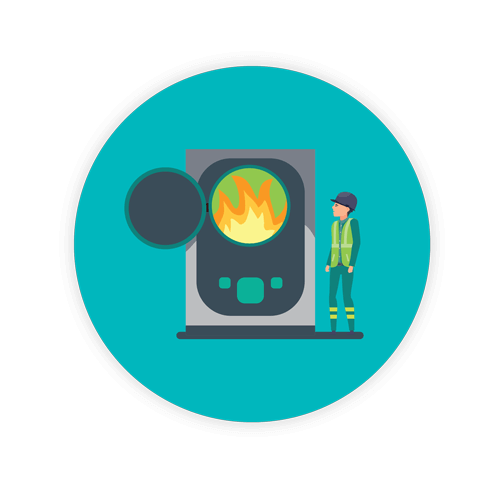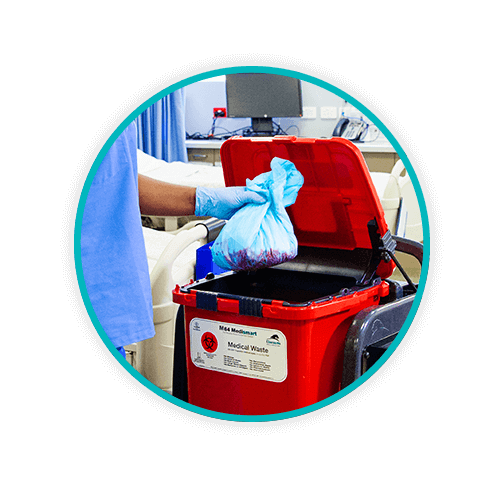What Happens to Medical Waste?

What happens to medical waste? That depends on whether it’s disposed of properly. If medical waste isn’t disposed of correctly, it has the potential to harm healthcare professionals and facility employees. Improperly segregated medical waste can end up where it doesn’t belong, like in a trashcan or the landfill. Non-compliant disposal of medical waste can even end up on our beaches or in the water, damaging the environment and imposing a huge risk to the general public.
Categorizing medical waste
The majority of healthcare providers that produce medical waste (medical waste generators), segregate it appropriately – between what is regulated and what isn’t. What happens to each type is different.
A general description of medical waste is anything that is produced in the care of a human or animal. Think wound care, disposable syringes, soiled bedding, surgical waste, chemotherapy waste, and so on. Each type of waste should be separated at its point of origin and disposed of properly to reduce the risk of transferring infections, viruses, parasites, and other dangerous materials between one person and another.
Most of the medical waste produced in the United States is unregulated, but that doesn’t mean that it shouldn’t be segregated and transported or disposed of based on federal and state guidelines. A small percentage of medical waste is regulated. Look to state and/or federal guidelines regarding waste stream identification, separation, appropriate containers or bags that such waste is to be disposed in, as well as where and how it can be stored.
In the US, general categorizations for medical waste streams are defined:
- Contaminated sharps are any sharp object including needles, syringes, scalpel blades, trocars, or other medical tools that have the potential to pierce or slash skin. Sharps are to be immediately placed into a compliant and approved sharps container that is leak-proof, puncture-proof, tear-proof, and resistant to spills. Sharps containers with special lids prevent accidental needlestick injury with use and are recommended.
- Biohazardous waste includes blood and blood-related products such as plasma, serum, and of course, blood. Anything with blood on it is typically considered biohazardous waste.
- Pharmaceutical waste is defined as any discontinued, expired, opened, used, or contaminated medication that is used for humans or animals. A recent law has prohibited “dumping” medications or unused or expired pharmaceuticals down sinks, toilets, or sewer drains. (Maximum fines can amount to more than $70,000 per day, per violation, so it is essential that staff is trained and knowledgeable about proper collection and disposal).
- Pathology wastes are typically generated from tissue samples used for testing and diagnosis. Basically, any part of a human or animal that has been taken from the body for testing would fit into the category of pathological waste.
- Microbiological waste can also be deemed infectious and should also be carefully handled in order to avoid exposure of contaminants to healthcare workers or the general public. Microbiological waste can include culture dishes, live vaccines, or other types of infectious laboratory waste.
Other categories can apply, depending on scenario, such as isolation waste, or waste produced by humans or animals who are quarantined or otherwise isolated from other patients due to communicable and infectious diseases such as Ebola.
Treatment of medical waste
Depending on type of waste, a handful of treatment methods are commonly used. They include:
- Autoclaving (thermal)
- Incineration
- Chemical
- Biohazardous
- Microwave (Irradiative)
Each of these methods for treatment is either done on-site or off-site, depending on the amount of waste, the type of medical waste generator, and of course, state regulations. Incineration is typically effective for treatment of pharmaceutical and pathological waste. Autoclave or thermal treatments are commonly used to deal with infectious waste and sharps waste. It is not used to treat pathological waste.
Microwave or irradiative treatment is another way that infectious and sharps waste is treated prior disposal, but again, not suitable for treatment of pathological waste. Chemical treatments are generally intended for liquid wastes such as cleaning materials used in the laboratory and for chemical waste cleanup. The last form of treatment is called biological or enzymatic, but it’s not typically used in most scenarios for medical waste treatment prior to disposal.
Disposing of medical waste
Depending on geographical location, the size of the waste generator, and whether certain waste streams can be treated on-site, transportation and ultimate disposal of waste differs. One thing to remember is the not only moral, but legal obligations to take the cradle-to-grave approach.
Daniels Health stands behind these guidelines and reminds all medical waste generators that they are the ultimate responsible party for ensuring that medical waste is transported and ultimately disposed of properly. Your responsibility doesn’t end the moment the waste management truck picks up your waste. You are also responsible for ensuring that it is properly disposed of, in a landfill, through incineration, and so forth.
Some medical waste disposal companies pick up certain types of waste streams. Depending on location and size, others may provide numerous options for pick-up. Medical waste services should be properly licensed and have the proper equipment to do the job. They must also be licensed and insured and 100% compliant with state and federal laws.
When selecting a medical waste transportation or disposal service, a number of federal requirements, laws, and state and local regulations must be met. These laws are set by not only state governmental offices, but the Environmental Protection Agency, the Centers for Disease Control, and the Occupational Safety and Health Administration.
The EPA provides relevant, timely, and informative guidelines on a state-by-state basis for medical waste management. The CDC’s guidelines for infection control provide information on control and management of regulated medical waste.
With information regarding numerous medical waste topics available online and easily accessible from any governmental agency, there is no excuse for “I didn’t know” when it comes to non-compliance. In some cases, state guidelines are even more detailed than those of the federal government. If in doubt which to follow, follow them both.
A place for everything
Daniels Health provides services, resources, and products to ensure that medical waste is properly segregated, handled, and stored for ultimate disposal. Containers for every waste stream should be found in all healthcare facilities and meet federal guidelines for structure, safety, and security. Daniels Health focuses on compliance and responsibility when it comes to healthcare medical waste. Contact us today for resources, solutions, product, and information for treatment of your medical waste.
Let's Talk!
Your time is valuable, and we don’t want to play hard to get. You can either phone us directly on the details listed on our contact page, or feel free to fill out this short form and one of our team members will get back to you as quickly as possible.
